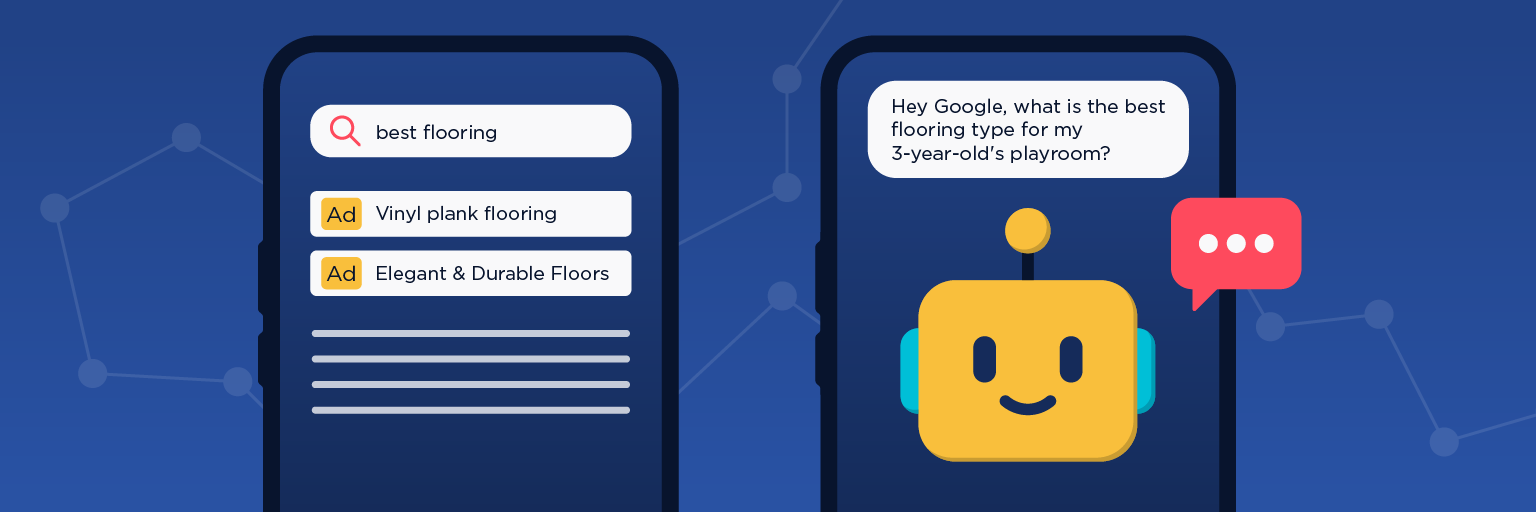Remember the good ol’ days of search? You’d type “best flooring” into a little box, hit enter, and a list of the top 10 sites would appear. Simple, clean, and predictable. As experts, we obsessed over the perfect keywords, ad headlines & descriptions, and the perfect title tag to match.
But now, Conversational AI has entered the chat. And it’s not playing by the old rules. This isn't just about a search box anymore; it’s about a conversation. Instead of typing a collection of words, people are asking. "Hey Google, what is the best flooring type for my 3-year-old’s playroom?" The AI doesn't just show you links; it gives you a direct, human-like answer. Suddenly, we all have a hyper-intelligent shopping assistant right inside our pockets.
The way customers find businesses like yours is undergoing a massive change, and it's happening right now. If your competitors learn to leverage conversational AI and you don't, you risk losing visibility and market share. This shift could make your brand invisible to a growing number of potential customers, hurting your ability to attract new business and meet your goals.
Historically, paying for the top position guaranteed visibility for your business. So, where does search engine marketing come into play? Are the days of pay-per-click over?
Paid Search Shift - From Top 3 to AI Mentions
This isn't about throwing your old strategy in the trash. It's about evolving it. Think of it less like an ending and more like a level-up. Paid ads used to be about buying a spot at the top of the search results page. Now, they're about being part of the conversation.
Google is Prepared to Roll Out Ads in AI Mode: Google is prepping to roll ads into conversational AI in Q4 of 2025. Google has released an internal document, first reported by Ad Age, revealing how ads will function in its new AI Mode. The document explains that ads will target users based on the entire AI conversation, not just a single query. This moves away from traditional in-the-moment keyword-based targeting.
To appear in AI Overviews when Google begins to monetize them, the first and most critical step is to properly set up your Google Ads campaigns.
From Keywords to Conversations: You need to stop writing for robots and start writing for people. Your campaign optimization can no longer entirely be a rigid, keyword-specific phrase-match campaign. Queries of 8+ words are up 700% in the past year. Adopting Google’s tools like broad match keywords, AI Max for Search, and Performance Max campaigns will be critical to joining the conversation where users are searching, not just placing in the top 10 search results.
- Prioritize Broad Match Keywords: Update your existing campaigns by transitioning to broad match keywords. While this may feel counterintuitive, it allows your ads to appear for the 8+ word conversational queries that are now so common. This single change gives your campaigns the flexibility to show up in the new conversational searches that hours of manual keyword research would never uncover.
- Launch a Performance Max Campaign: If you haven't already, launch a Performance Max campaign. This AI-driven campaign type leverages machine learning to find your most valuable customers across all of Google's channels—from Search to YouTube to Discover. It's built to capture the kinds of high-intent, conversational queries that are now driving clicks.
High-Intent is Your New Friend
If you’ve experimented with Google Ads’ AI tools, such as a Performance Max campaign, then you know the frustration that comes along with the lack of transparency in our historical data points – search terms, where the ad was placed (Google, YouTube), etc. We aren’t suggesting these campaigns be your only strategy. As AI handles the simple questions, you can focus portions of your ad spend on the high-intent queries, the moments that AI can’t just summarize right away. Think, “buy Shaw Pet Perfect flooring near me” instead of “what’s the best flooring?”
Embrace New Metrics
Your old friend, the click-through rate, may decline. In this new landscape, success is measured by brand visibility and share of voice within AI overviews. When the AI cites your brand, that's a win, positioning you as an authority even without a direct click. You might not get the click, but you’ve been positioned as an authoritative voice and a brand worth remembering.
Search Everywhere Optimization
Search is no longer just on Google. A new generation of users is turning to social platforms like TikTok and Instagram for product discovery and reviews. So while you’re figuring out your AI strategy, don’t forget to build a presence on these new platforms.
This new landscape can feel a little intimidating. But the future of paid advertising isn’t about fighting a new wave of technology – it’s about learning how to use it to your advantage.
Though Google has been preparing its monetization of conversational AI, not all platforms are rushing to adopt this mindset. Major players like OpenAI’s ChatGPT have so far kept their main conversational experiences ad-free, instead focusing on subscription models. ChatGPT’s CEO has gone so far as to say it will be a “last resort” for the platform.
Instead of chasing keywords and search phrases, build a brand that AI wants to recommend. It’s not about one-time bidding on one keyword; it’s establishing your business as the expert across multiple platforms.
Sources:
https://searchengineland.com/google-ai-mode-ads-internal-document-459931
https://www.theverge.com/news/759140/openai-chatgpt-ads-nick-turley-decoder
https://developers.google.com/search/docs/fundamentals/creating-helpful-content
https://adage.com/technology/google/aa-ai-mode-ad-launch-what-brands-should-know/
https://www.clerkswell.com/insights/how-ai-is-changing-consumer-behaviour/

